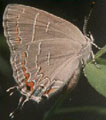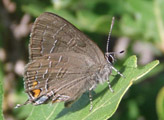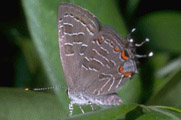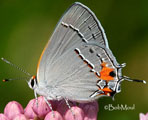Native Plants
Search for native plants by scientific name, common name or family. If you are not sure what you are looking for, try the Combination Search or our Recommended Species lists.
Crataegus crus-galli
Crataegus crus-galli L.
Cockspur Hawthorn, Cockspur Thorn, Newcastle Hawthorn, Newcastle Thorn, Hog Apple
Rosaceae (Rose Family)
Synonym(s): Crataegus acutifolia, Crataegus acutifolia var. insignis, Crataegus algens, Crataegus barrettiana, Crataegus bushii, Crataegus canbyi, Crataegus cherokeensis, Crataegus cocksii, Crataegus crus-galli var. barrettiana, Crataegus crus-galli var. bellica, Crataegus crus-galli var. capillata, Crataegus crus-galli var. exigua, Crataegus crus-galli var. leptophylla, Crataegus crus-galli var. macra, Crataegus crus-galli var. oblongata, Crataegus crus-galli var. pachyphylla, Crataegus crus-galli var. pyracanthifolia, Crataegus danielsii, Crataegus denaria, Crataegus fecunda, Crataegus fontanesiana, Crataegus hannibalensis, Crataegus mohrii, Crataegus operta, Crataegus palliata, Crataegus palmeri, Crataegus permixta, Crataegus pyracanthoides, Crataegus regalis, Crataegus regalis var. paradoxa, Crataegus sabineana, Crataegus schizophylla, Crataegus signata, Crataegus subpilosa, Crataegus tantula, Crataegus tenax, Crataegus triumphalis, Crataegus uniqua, Crataegus vallicola
USDA Symbol: CRCR2
USDA Native Status: L48 (N), CAN (N)
Cock-spur hawthorn is a small, globular, deciduous tree with a short trunk; exfoliating bark; horizontal, thorny branches which sweep the ground; and thick, glossy foliage which turns bright orange or red in fall. Profuse clusters of white flowers are followed by small, red "apples," persistent until January. Small, spiny, thicket-forming tree with short, stout trunk and broad, dense crown of spreading and horizontal branches; hairless throughout. The tree grows 20-35 ft. tall with an equal spread.
The common and Latin species names both describe the numerous and extremely long spines, which are used locally as pins. The long spines and shiny dark green spoon-shaped leaves make this one of the most easily recognized hawthorns. Common and widespread, it has been planted for ornament and as a hedge since colonial times.
Plant Characteristics
Duration: PerennialHabit: Tree
Leaf Retention: Deciduous
Fruit Type: Pome
Size Notes: Up to about 35 feet tall.
Leaf: Green
Autumn Foliage: yes
Fruit: Red
Bloom Information
Bloom Color: White , PinkBloom Time: May , Jun
Distribution
USA: AL , AR , CT , DC , DE , FL , GA , IA , IL , IN , KS , KY , LA , MA , MD , ME , MI , MN , MO , MS , NC , NJ , NY , OH , OK , PA , RI , SC , TN , TX , VA , VT , WI , WVCanada: ON , QC , SK
Native Distribution: VT & adjacent Canada to SC, w. to s. WI, e. KS & e. TX
Native Habitat: Fence rows, Hillsides, Slopes, Thickets
Growing Conditions
Water Use: LowLight Requirement: Sun , Part Shade , Shade
Soil Moisture: Dry , Moist
Soil pH: Acidic (pH<6.8)
CaCO3 Tolerance: High
Drought Tolerance: High
Soil Description: Variable, preferring moist, well-drained soils. Sandy, Sandy Loam, Medium Loam, Clay Loam, Clay.
Conditions Comments: The low, densely set branches make it difficult to grow grasses under this tree. The tree is susceptible to fire blight, several species of rust, and insect damage, but is tolerant of city pollution. Prune in winter or early spring. This tree produces some of the longest thorns of any hawthorn, but a thornless variety, var. inermis, is available.
Benefit
Use Ornamental: Blooms ornamental, AttractiveUse Wildlife: Cover,Nesting material, Fruit-birds, Fruit-mammals.
Warning: Plant has thorns or prickles.
Conspicuous Flowers: yes
Fragrant Flowers: yes
Attracts: Birds , Butterflies
Larval Host: Striped hairstreak, Banded hairstreak, Soapberry hairstreak, King's hairstreak, Gray hairstreak.
Value to Beneficial Insects
Special Value to Native BeesSupports Conservation Biological Control
This information was provided by the Pollinator Program at The Xerces Society for Invertebrate Conservation.
Butterflies and Moths of North America (BAMONA)
|
Soapberry Hairstreak (Phaeostrymon alcestis)  Larval Host |
Banded Hairstreak (Satyrium calanus)  Larval Host |
Striped Hairstreak (Satyrium liparops)  Larval Host |
Gray Hairstreak (Strymon melinus)  Larval Host |
Propagation
Seed Treatment: Dry seed should be immersed in acid for 2-3 hours then warm stratified at 70-77 degrees for 120 days followed by 135 days at 41 degrees.Commercially Avail: yes
National Wetland Indicator Status
| Region: | AGCP | AK | AW | CB | EMP | GP | HI | MW | NCNE | WMVE |
| Status: | FAC | FACU | FAC | FAC | FAC |
From the National Organizations Directory
According to the species list provided by Affiliate Organizations, this plant is on display at the following locations:Mt. Cuba Center - Hockessin, DE
Bibliography
Bibref 298 - Field Guide to Texas Trees (1999) Simpson, B.J.Bibref 946 - Gardening with Prairie Plants: How to Create Beautiful Native Landscapes (2002) Wasowski, Sally
Bibref 841 - Native Alternatives to Invasive Plants (2006) Burrell, C. C.
Bibref 291 - Texas Wildscapes: Gardening for Wildlife (1999) Damude, N. & K.C. Bender
Bibref 297 - Trees of Central Texas (1984) Vines, Robert A.
Search More Titles in Bibliography
Web Reference
Webref 3 - Flora of North America (2014) Missouri Botanical Garden, St. Louis, MO & Harvard University Herbaria, Cambridge, MA.Additional resources
USDA: Find Crataegus crus-galli in USDA PlantsFNA: Find Crataegus crus-galli in the Flora of North America (if available)
Google: Search Google for Crataegus crus-galli
Metadata
Record Modified: 2022-10-05Research By: TWC Staff